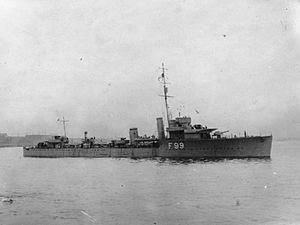Name HMS Valentine Ordered July 1916 Commissioned 27 June 1917 Construction started 7 August 1916 Length 95 m | Owner Royal Navy Laid down 7 August 1916 Out of service 15 May 1940 Launched 24 March 1917 Builder Cammell Laird | |
 | ||
HMS Valentine was a V and W-class destroyer, built in 1917 for the Royal Navy. She fought in both world wars, serving in several capacities. She was heavily damaged by air attack and beached in 1940 near Terneuzen. Her hulk remained there until it was broken up in 1953.
Contents
Construction and design
In early 1916, the British Royal Navy had a requirement for a destroyer leader suitable for leading the new, fast, R-class destroyers. To meet this requirement, the Director of Naval Construction prepared the design of a new class of ships, smaller and cheaper than the existing Marksman and Parker-classes, but still capable of accommodating the additional staff required to command the destroyer flotilla and carrying the same armament. Five ships of the new class were ordered in April–July 1916, with Valentine one of two ships ordered from Cammell Laird in July that year at a tender price of £218,000 per ship. Valentine was laid down at Cammell Laird's shipyard in Birkenhead on 7 August 1916, was launched on 24 March 1917 and completed on 27 June 1917.
The ship's machinery was based on that of the R-class destroyers, with three Yarrow boilers feeding Brown-Curtiss geared steam turbines which drove two propeller shafts. The machinery generated 27,000 shaft horsepower (20,000 kW), giving a design speed of 34 knots (63 km/h; 39 mph). A maximum of 367 tons of fuel oil could be carried, giving a range of 3,500 nautical miles (6,500 km; 4,000 mi) at a speed of 15 knots (28 km/h; 17 mph).
The ship's main gun armament was four 4 inch (102 mm) QF Mk V guns on CP.II mountings, with two mounts forward and two aft in superimposed positions. These guns, which were provided with 120 rounds per gun, could elevate to 30 degrees, allowing them to fire a 31 pounds (14 kg) shell a distance of 13,840 yards (12,660 m). Anti-aircraft armament consisted of a single 3 inch (76 mm) QF 20 cwt gun, which was preferred to the 2-pounder "Pom-Poms" fitted to previous leaders, while torpedo armament consisted of four 21 inch (53 cm) torpedo tubes in two twin mounts.
First World War and Baltic campaign
On completion, Valentine served with the Grand Fleet, as part of the 13th Destroyer Flotilla and the 6th Light Cruiser Squadron. When commissioned, Valentine was assigned the pennant number F99, which was changed to F30 in January 1918. In October 1917, Valentine was deployed as part of an elaborate anti-submarine operation, in which destroyers and submarines were to be used to drive German U-boats that were returning to port from operations and passing to the east of the Dogger Bank into a large (several miles long) array of mine nets. Valentine was one of six destroyers whose job was to escort the drifters deploying the nets. The operation lasted for 10 days, and British Intelligence believed that three U-boats were probably sunk in the operation. However, the submarines in question were almost certainly lost in other mine-fields. Later that month, Valentine formed part of the destroyer escort to the 6th Light Cruiser Squadron when it was deployed as part of a scheme to attack German minesweepers in the Heligoland Bight. This resulted in the inconclusive Second Battle of Heligoland Bight. An attempt by Valentine and the destroyer Vanquisher to carry out a torpedo attack on German cruisers proved unsuccessful.
In 1919, Valentine was deployed to the Baltic Sea as part of the British intervention in the Russian Civil War, which helped to ensure the independence of the Baltic states.
Peace-time service
Post-war, Valentine formed part of the 2nd Destroyer Flotilla, first as part of the Atlantic Fleet and later as part of the Mediterranean Fleet. In the 1920s, Valentine's twin torpedo tubes were replaced by triple tubes, giving a torpedo armament of six 21 inch torpedoes, and the 12-pounder anti-aircraft gun was replaced by a 2-pounder "pom-pom".
Conversion
In 1936, the Admiralty recognised that the Royal Navy had a shortage of escort ships with good anti-aircraft armament, suitable for operations along the East coast of the Great Britain. As well as building a new class of escort destroyers designed for this role (the Hunt-class escort destroyers), it was decided to convert a number of old destroyers of the V and W classes, now obsolete as fleet destroyers, to perform a similar role. This programme became known as the "Wair" conversions. The conversion involved the replacement of the ship's entire armament. Two twin QF 4 inch Mk XVI naval gun anti-aircraft mounts were fitted, with a modern fire control system mounted on a new superstructure to direct their fire. Two quadruple Vickers .50 machine gun mounts provided close-in anti-aircraft armament. Modern sonar, and a relatively powerful depth-charge outfit of 30 depth charges provided the ship's anti-submarine equipment. No torpedo tubes were fitted.
Valentine was selected as one of the destroyers to undergo the Wair conversion, being converted at Devonport Dockyard, Plymouth between June 1939 and 23 April 1940.
Loss
After completing work-up, Valentine joined the Nore Command, responsible for East coast convoys, transferring to Dover Command in May. Valentine was one of four destroyers deployed to the Scheldt estuary to support demolition operations and the evacuation of shipping from Antwerp. While providing AA cover to Allied troops, Valentine was damaged by dive bombers on 15 May 1940, and beached near Terneuzen. 31 of Valentine's crew were killed, with a further 21 injured. Valentine was partly salvaged and broken up in 1953, but part of the ship's hull remains and is sometimes visible at low tide.
